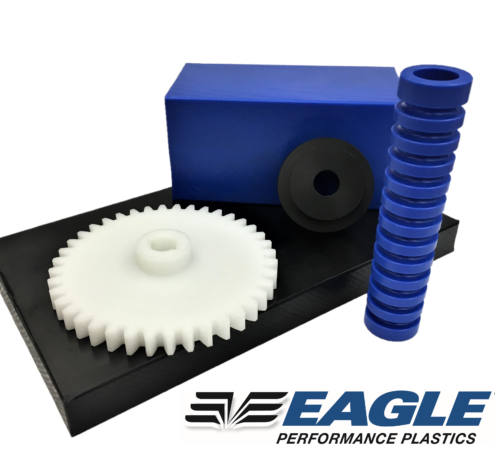PBI Unfilled

PBI Unfilled Overview
What is the Material: PBI Unfilled is an amorphous imidized materials.
Key Material Features: This material is beneficial in applications requiring wear resistance, strength, and it maintains properties in extreme temperatures. It is the hardest and highest performing unfilled thermoplastic.
Other Considerations: It holds up in extreme temperatures better than other thermoplastics including PEEK, PAI, and PI. Other plastics do not stick to PBI when melted. This material is attacked by hot water and steam.
Physical
| Property | Value | Typical ASTM Test |
|---|---|---|
| Chemical Designation | (PBI) Polybenzimidazole | |
| Trade Names (®, ™) | Duratron PBI | |
| Color | Black | |
| Density (g/cm^3) | 1.30 | D 792 |
Mechanical
| Property | Value | Typical ASTM Test |
|---|---|---|
| Modulus of Elasticity (Tensile Test) (psi) | 850000 | D 638 |
| Tensile Strength at Yield (psi) | 16000 | D 638 |
| Elongation at Break (%) | 2 | D 638 |
| Flexural Strength (psi) | 32000 | D 790 |
| Modulus of Elasticity (Flexural Test) (psi) | 950000 | D 790 |
| Compression Strength: 10% Strain (psi) | 50000 | D 695 |
| Compression Modulus (psi) | 900000 | D 695 |
| Impact Strength (Izod) (ft-lbs/in) | 0.5 | D 256 |
| Hardness (D) | 94 | D 785 |
| Hardness (E) | 105 | |
| Hardness (M) | 125 | D 785 |
| Coefficient of Friction (Kinetic, 40 psi, 50 fpm) | 0.24 | D 3702 |
| Wear (K) Factor (in^3-min/ft-lbs-hr) (Against Steel, 40 psi, 50 fpm) | 6.00E-9 | D 3702 |
Thermal
| Property | Value | Typical ASTM Test |
|---|---|---|
| Glass Transistion Temperature (°F) | 775 | D 3418 |
| Deflection Temperature (°F) (264 psi) | 800 | D 648 |
| Service Temperature Continuous (°F) | 600 | |
| Thermal Expansion (CLTE) (in/in/°F) | 1.30E-5 | D 696 |
| Thermal Conductivity (BTU-in/hr-ft^2-°F) | 2.80 |
Electrical
| Property | Value | Typical ASTM Test |
|---|---|---|
| Specific Surface Resistance (Ω/square) | 1.00E13 | D 257 |
| Dielectric Strength (V/mil) | 550 | D 149 |
| Dissipation Factor (1MHz) | 0.0030 | D 150 |
| Dielectric Constant (1MHz) | 3.2 | D 150 |
Other
| Property | Value | Typical ASTM Test |
|---|---|---|
| Moisture Absorption (%) (24 Hours) | 0.4 | D 570 |
| Moisture Absorption (%) (Saturated) | 5 | D 570 |
| Flammability | V-0 |
The data stated are typical values intended for reference and comparison purposes only. The data should not be used as a basis for design specifications or quality control. The information is provided as a guide to the best of our knowledge and given without obligation or liability. Testing under individual application circumstances is recommended.
